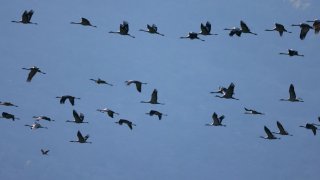
A strain of highly pathogenic avian influenza has been detected in Michigan in a non-commercial backyard flock of birds in Kalamazoo County, federal authorities said Thursday.
Samples from the flock were tested at Michigan State University's Veterinary Diagnostic Laboratory and confirmed by the USDA’s Animal and Plant Health Inspection Service laboratories in Ames, Iowa.
State officials have quarantined the Kalamazoo County site and the 34 birds at that property “will be depopulated to prevent the spread of disease,” the USDA said, noting that birds from that flock will not enter the food system.
It's the first case of avian flu in Michigan, said Lyndsay Cole, a USDA spokeswoman. It's not clear how it reached the backyard flock, she said.
The virus strain is potentially deadly to commercial poultry.
The bird flu cases are among the latest in the U.S. that have put farms that raise turkeys and chickens for meat and eggs on high alert, fearing a repeat of a 2015 bird flu outbreak that killed 50 million birds across 15 states and cost the federal government nearly $1 billion.
Bird flu has also been detected at commercial turkey farms in southern Indiana, a flock of commercial broiler chickens in Kentucky, a commercial poultry flock in Delaware, a backyard flock of mixed species birds in northern Virginia, and in New York and Maine, both at a single non-commercial backyard flock.
Local
The U.S. Centers for Disease Control says the recent bird flu detections do not present an immediate public health concern. No human cases of these viruses have been detected in the U.S.
Yes, the case in backyard poultry in Kalamazoo County is the first case of HPAI in Michigan. There were 34 birds in the flock and they have been depopulated.
Feeling out of the loop? We'll catch you up on the Chicago news you need to know. Sign up for the weekly Chicago Catch-Up newsletter.
APHIS is working closely with State animal health officials to conduct epidemiological testing to look into the origins of these cases. It is important to note that this is the same Eurasian lineage H5 clade that was brought to the United States in 2014/2015 by wild birds, and also the same one that has been found in wild birds in the Atlantic flyway in January.



